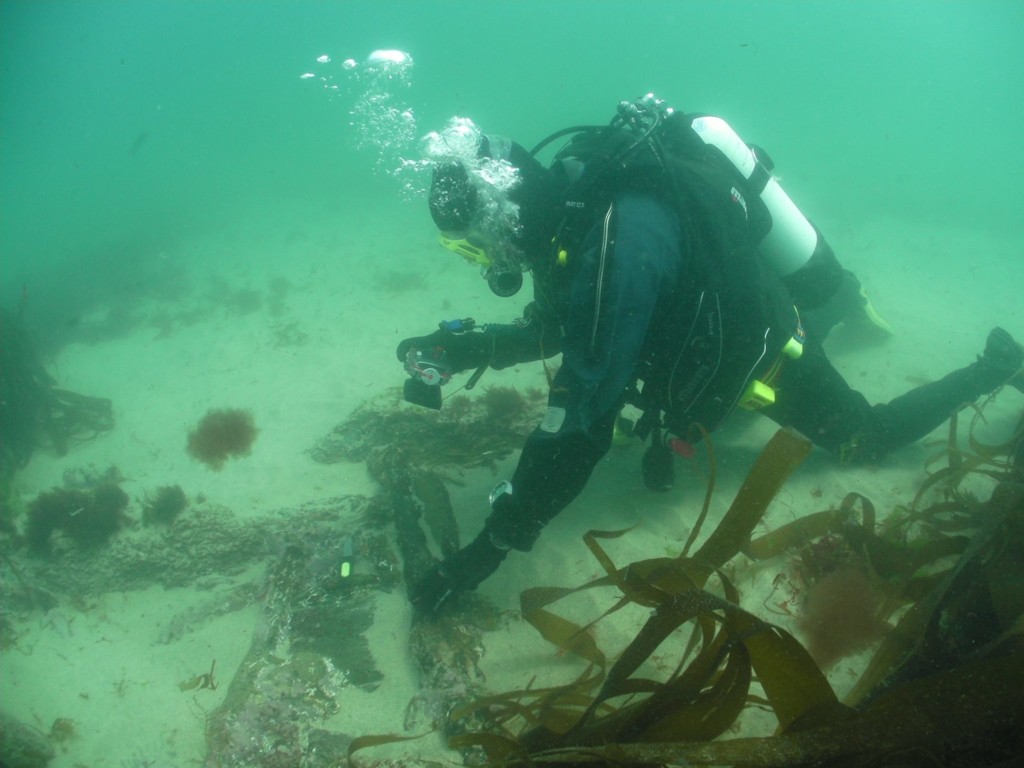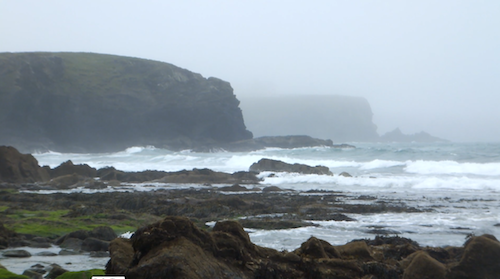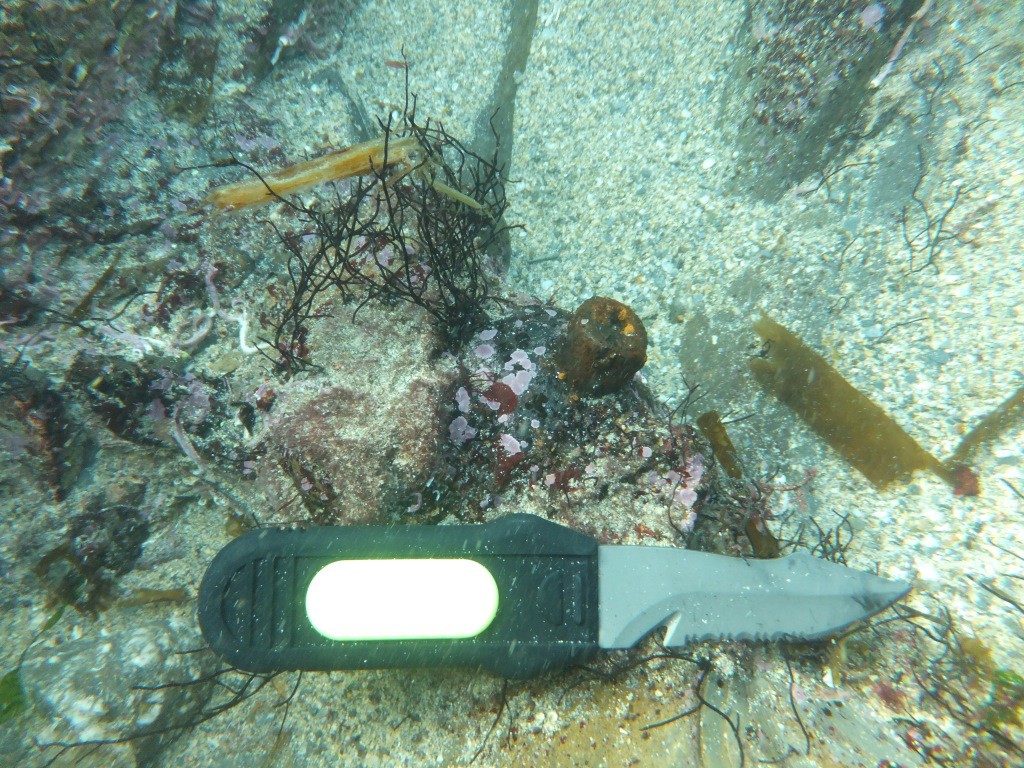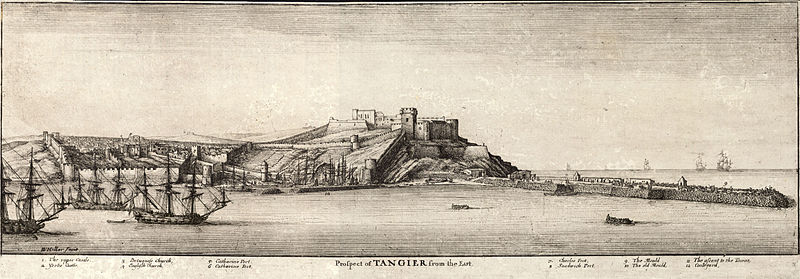News
Divers off Cornwall Discover Poldark Shipwreck

Divers have rediscovered a 17th century shipwreck off Gunwalloe Church Cove in Cornwall, at exactly the spot where the shipwreck scene was filmed in 2014 for the TV series Poldark. First seen by a local diver in 1971 and designated under the Protection of Wrecks Act 1973, the wreck of the Schiedam had been buried for many years under the shifting sands of the cove. The site is now managed by Historic England and dived by a keen local team. The two divers who rediscovered the site this year, novelist and archaeologist David Gibbins and Mark Milburn, of Atlantic Scuba in Penryn, describe the moment:
“We’d searched the cove many times for the Schiedam, but only seen sand. Then the breakthrough came one day after a storm. Snorkelling north over the cove, we saw not just one cannon, but three. It was incredibly exciting. One of the guns was among the longest we’d ever seen on a wreck, standing proud of the seabed on a rocky ledge with the muzzle poking out, almost as if it were on a gun carriage. Exploring the reefs around the guns, we saw other amazing artefacts – concreted musket barrels, cannon balls, lead musket and pistol shot, and even an iron hand-grenade, the wooden plug for the fuse still intact. We knew that most of what we were seeing was cargo carried from the English colony at Tangier, making the wreck a fascinating window into a forgotten corner of history.”

Archaeologist David Gibbins photographing musket barrels revealed this year on the wreck of the Schiedam (photo: Mark Milburn)
Historic England has management responsibilities for the site but the involvement of divers ensures that the site is monitored. The approach to the historic wreck sites championed by Historic England is that they are a shared resource for all to access and enjoy. Historic England’s Maritime Archaeologist Alison James said: “We are delighted to work with divers like Mark and David to help ensure that England’s protected wreck sites are enjoyed and protected for years to come. They are helping to ensure that the story of the site is not lost and is known to a wider audience.”
The Schiedam has one of the richest backstories of any wreck ever discovered in British waters. At the time of her loss in April 1684 she was part of a fleet carrying ordnance, tools, horses and people back from Tangier, the port in present-day Morocco that had been acquired by the English King Charles II as a dowry with his Portuguese wife, but had been abandoned by the English in the face of Moorish threat. The Schiedam herself was originally Dutch, a merchantman sailing from Holland, but had been captured by Barbary pirates off Spain in 1683 and her crew enslaved.

The site of the wreck of the Schiedam off Gunwalloe, Cornwall, at exactly the same location as the shipwreck scene filmed in the TV series Poldark (photo: David Gibbins)
Soon afterwards she was captured again, this time by a Royal Navy ship commanded by a daring young captain named Cloudesley Shovell – later as an admiral to be lost with his fleet in 1707 in the Scilly Isles through a navigational error, the trigger for the race to find a better way of establishing longitude – who brought his prize to Tangier. As if that were not enough, none other than the diarist Samuel Pepys enters the picture, as he was an Admiralty official sent to Tangier to help oversee the evacuation. Much of his correspondence relating to the wreck of the Schiedam still survives.
The big gun that the divers saw on the wreck was a demi-culverin, one of a number recorded among the ordnance at Tangier but the only one from the colony known to survive. The hand-grenade is particularly fascinating as one of the earliest known examples to be found archaeologically, and because their use is well-documented at Tangier. Invented in the 16th century, ‘hand-granadoes’ had only been a standard armament for English regiments for a few years by the time of the Tangier colony. Nevertheless, they were among the first list of equipment requested for the colony in 1662 and played a pivotal role in the defence against the Moors. When one of the outlying forts was captured by the Moors after savage fighting in 1680 they seized a large store of hand grenades and other armaments, swinging the siege in the Moors’ favour and helped to precipitate the English decision to abandon the colony a few years later.

A 17th century grenade found on the wreck of the Schiedam, complete with its wooden fuse plug (photo: David Gibbins)
The wreck dates a century before the setting of Poldark, but the similarities are striking. “You would have seen local people lining the shore just as the film crew were that day in 2014, and flotsam coming ashore at exactly the same place,” Gibbins said. A letter written soon after the wrecking to Lord Dartmouth, Admiral of the Fleet, suggests that the locals availed themselves of what they could but were far from the murderous Cornish wreckers of legend: “All the guns and mortar pieces may be saved, but palisades, muskets, rigging, are mostly embezzled, though the justices and gentlemen of the country are extremely civil and save what they could; and the country very kind to the poor people.”
Investigations of the Schiedam are carried out under the aegis of Historic England, which administers the Protection of Wrecks Act 1973 and issues discretionary licenses for divers to visit protected wreck sites off England. Further exploration of the Schiedam is planned for next year.
Gear News
Introducing the TR-80, IR-50 and CS-30 Regulators from DYNAMICNORD

Whether you are a beginner or a professional diver – with the three new main regulators from DYNAMICNORD, everyone will find their favourite regulator. They all look super stylish.
Excellent performance with the TR-80
Quality and performance are the be-all and end-all for regulators. It is not for nothing that the TR stands for Tec Reg. The innovative design of the TR-80 guarantees absolute reliability – even in ice-cold waters.

Perfect breathing effort at 0.8 J/l / certified for diving in waters below 10 degrees / structural design made of solid brass for best cold protection / membrane-compensated design with dry seal of the first stage / reduced exhalation effort thanks to optimized exhalation membrane and bubble deflector / adjustable Venturi (dive/predive) and adjustment knob for individual inhalation comfort / innovative design of the front cover prevents free-flow in strong currents or when diving with scooters / design made of sandblasted brass, matt chrome finish / 2 HP and 4 LP outlets / mouthpiece made of high-quality, anti-allergic silicone for maximum comfort.


Amazing underwater adventures with the IR-50
The IR-50 is the top regulator for advanced and experienced divers. Natural breathing is the essence of this regulator.

Ideal breathing effort at 0.8 J/l /certified for diving in waters below 10 degrees / compensated membrane / adjustable venturi (dive/predive) and adjustment knob for individual inhalation comfort/ outlet valve and deflector for minimum exhalation effort and reduction of bubbles on the face / design made of sandblasted brass, matt chrome finish / 2 HP and 4 NP outlets / mouthpiece made of high-quality, anti-allergic silicone for maximum comfort.


The Workhorse – our CS-30
For diving centres and diving beginners – the workhorse stands for strong construction, reliability and robustness. Perfect for your training.

Optimal breathing effort at 0.8 J/l /recommended for diving in waters above 10 degrees / non-compensated piston / adjustable venturi (dive/predive) / outlet valve and deflector for minimum exhalation effort and reduction of bubbles on the face / design made of sandblasted brass, matt chrome finish / 1 HP and 3 NP outlets / mouthpiece made of high-quality, anti-allergic silicone for maximum comfort.


Octopus OP-30
The OP-30 is the ideal addition to all DYNAMICNORD regulators. It is identical in construction to the CS-30.

The TR-80, IR-50, CS-30 (DIN & INT) regulators and the Octopus OP-30 are available from DYNAMICNORD dealers and in the online store.
DYNAMICNORD – Your Outdoor Companion.
Marine Life & Conservation
Paul Watson Released as Denmark Blocks Japan’s Extradition Bid

Renowned anti-whaling activist Paul Watson has been released from custody in Greenland after spending five months in detention. Denmark’s Justice Ministry rejected Japan’s request for his extradition, citing insufficient guarantees that his time already served in custody would be credited against any potential sentence.
The 74-year-old Canadian-American was arrested on July 21 in Nuuk, Greenland’s capital, when his ship docked to refuel. His arrest was based on a 2012 Japanese warrant related to a 2010 encounter in Antarctic waters. Japan alleged Watson obstructed operations and caused damage to a whaling research ship during efforts to disrupt illegal whaling. Watson has consistently denied these claims, maintaining his commitment to marine conservation.
Denmark, which oversees extradition matters for Greenland, concluded that while the legal conditions for extradition were met, the lack of assurances from Japan regarding time-served credit made extradition untenable.
In a video shared by his foundation, Watson expressed gratitude and relief, saying, “After five months, it’s good to be out… and good to know they’re not sending me to Japan.” He added that the most difficult part of his time in custody was being separated from his two young sons.
Watson is a pioneering figure in marine conservation, known for founding the Captain Paul Watson Foundation in 2022 after decades of activism with the Sea Shepherd Conservation Society. His bold efforts to defend marine life have earned him widespread support, including from celebrities and conservationists. His work has also been featured in the acclaimed reality TV series Whale Wars.
Watson’s lawyer, Jonas Christoffersen, praised the decision, stating, “We are happy and relieved that Paul Watson is now free.” He added that Watson is eager to reunite with his family and continue his vital work.
The arrest occurred while Watson’s vessel, the M/Y John Paul DeJoria, was en route to the North Pacific with a team of 26 volunteers to intercept a Japanese whaling ship. His foundation described the arrest as politically motivated and emphasized that Watson’s actions were focused on ending illegal whaling practices.
Japan resumed commercial whaling in 2019 after leaving the International Whaling Commission, asserting that whale meat is a cultural tradition. Conservationists, however, continue to challenge these practices, highlighting their impact on marine ecosystems.
Despite the challenges, Watson remains steadfast in his mission to protect marine life and bring attention to whaling practices. His dedication to ocean conservation has made him a globally respected advocate for the environment.
-

 News2 months ago
News2 months agoIconic SS United States to become the World’s Largest Artificial Reef
-

 News3 months ago
News3 months agoBook Review – 52 Assignments: Underwater Photography
-

 Gear News3 months ago
Gear News3 months agoDYNAMICNORD – New German diving brand enters the British market
-

 News3 months ago
News3 months agoExploring Cenote El Pit: A Diver’s Dream
-

 Gear News3 months ago
Gear News3 months agoTry BARE drysuits (and maybe even win one!) this Friday with Sea & Sea at North West Dive Fest
-

 Marine Life & Conservation3 months ago
Marine Life & Conservation3 months agoBook Review: Coral Triangle Cameos
-

 Blogs2 months ago
Blogs2 months agoDive the Egyptian Red Sea this Autumn with Regaldive
-

 News3 months ago
News3 months ago2024 Ocean Art Underwater Photo Competition Announced
















